Requirement Engineering Report: Cognizant Technology Solutions
VerifiedAdded on 2022/11/27
|16
|3400
|83
Report
AI Summary
This report examines requirement engineering from the perspective of a former project manager at Cognizant Technology Solutions (CTS), focusing on its usability and effectiveness within IT projects. It begins with an executive summary, outlining the report's objectives, which include exploring high-level concepts of requirement engineering, its role in achieving organizational success, and the value proposition of CTS. The report then delves into the procedures of requirement engineering, detailing requirement elicitation, analysis, system modelling, specification, and validation. It also addresses product implementation, software architectures, and CTS's technological capabilities. Furthermore, the report critiques best practices and discusses the future implications of microservices architecture, concluding with recommendations based on the analysis.
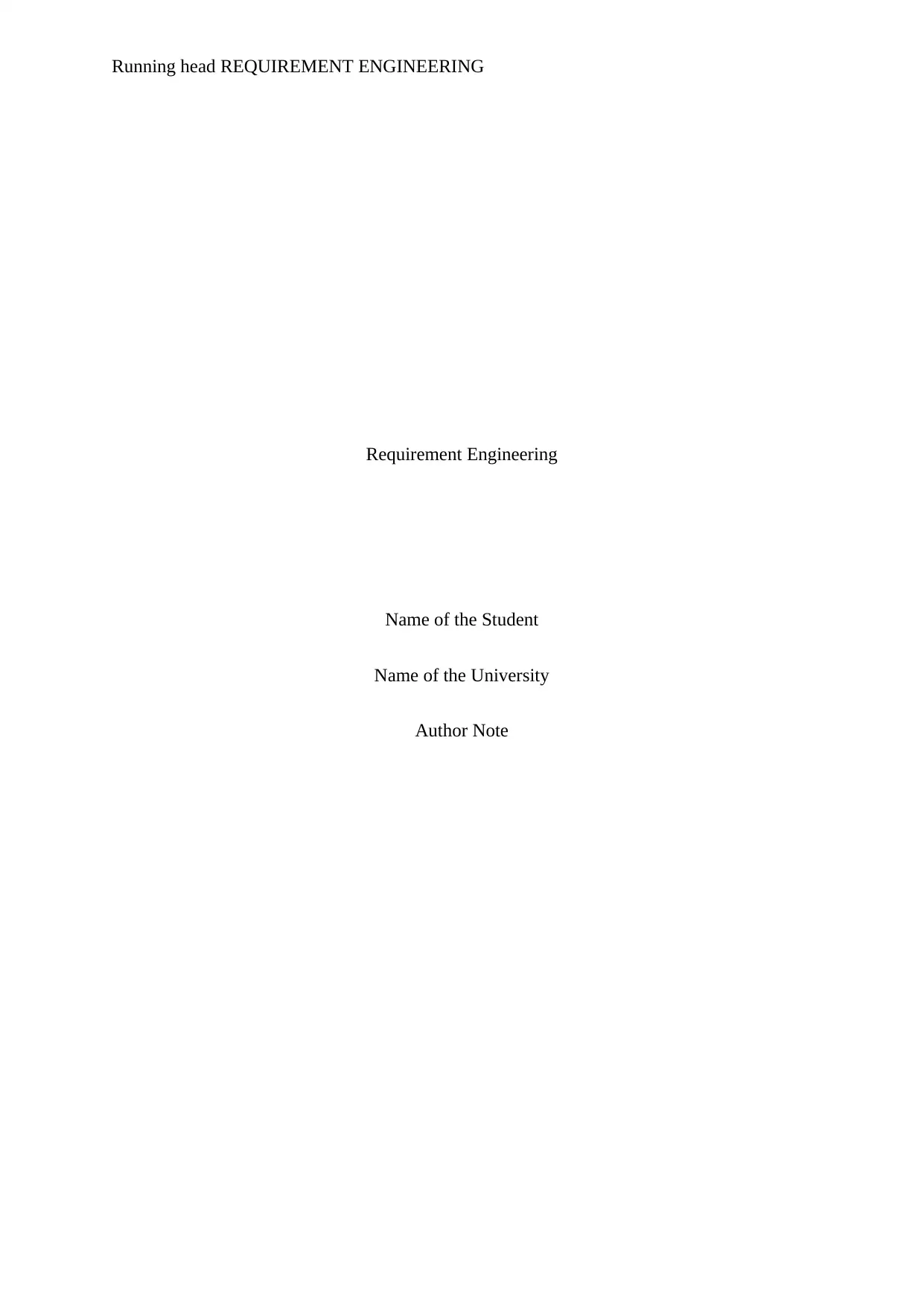
Running head REQUIREMENT ENGINEERING
Requirement Engineering
Name of the Student
Name of the University
Author Note
Requirement Engineering
Name of the Student
Name of the University
Author Note
Paraphrase This Document
Need a fresh take? Get an instant paraphrase of this document with our AI Paraphraser
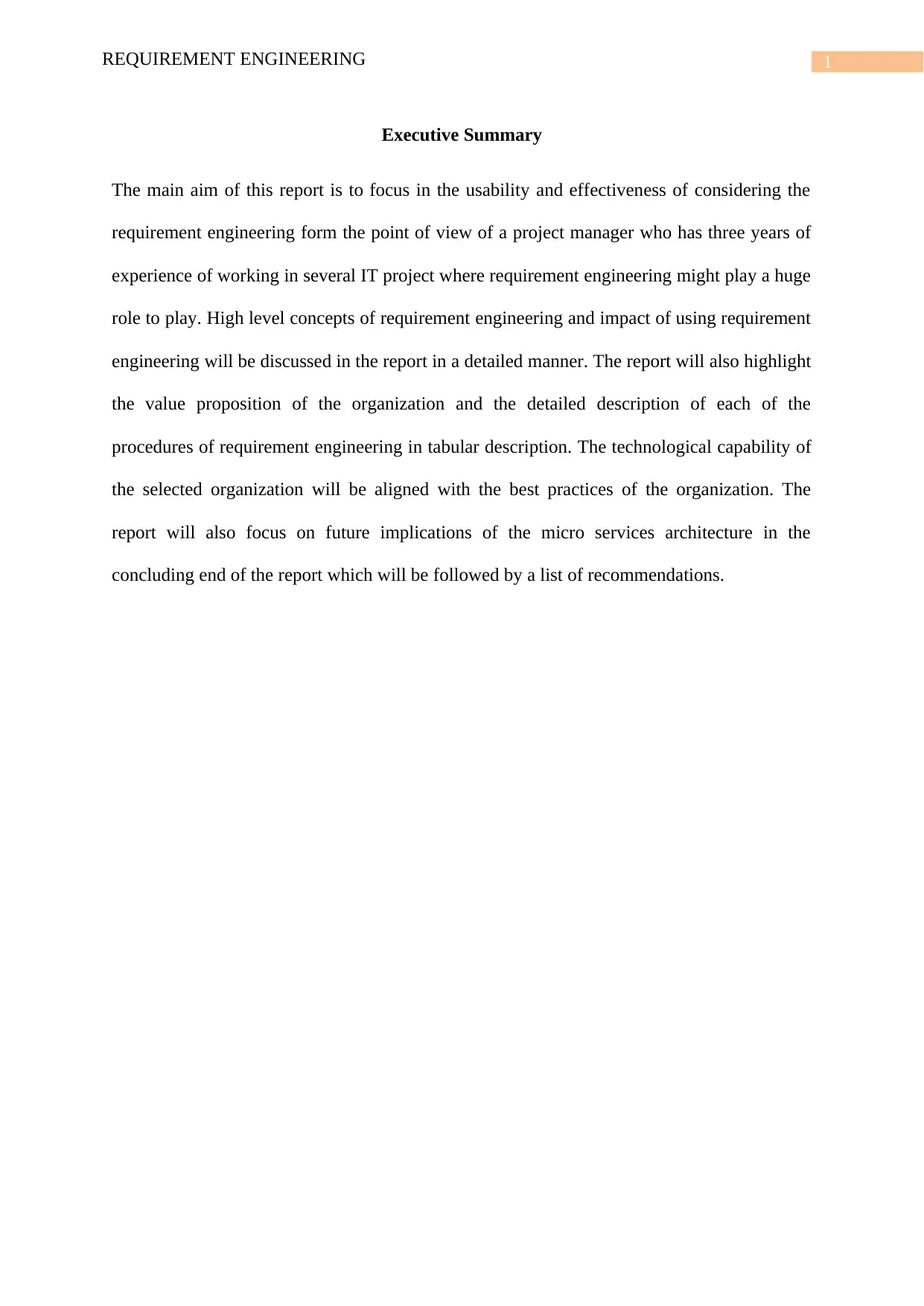
1REQUIREMENT ENGINEERING
Executive Summary
The main aim of this report is to focus in the usability and effectiveness of considering the
requirement engineering form the point of view of a project manager who has three years of
experience of working in several IT project where requirement engineering might play a huge
role to play. High level concepts of requirement engineering and impact of using requirement
engineering will be discussed in the report in a detailed manner. The report will also highlight
the value proposition of the organization and the detailed description of each of the
procedures of requirement engineering in tabular description. The technological capability of
the selected organization will be aligned with the best practices of the organization. The
report will also focus on future implications of the micro services architecture in the
concluding end of the report which will be followed by a list of recommendations.
Executive Summary
The main aim of this report is to focus in the usability and effectiveness of considering the
requirement engineering form the point of view of a project manager who has three years of
experience of working in several IT project where requirement engineering might play a huge
role to play. High level concepts of requirement engineering and impact of using requirement
engineering will be discussed in the report in a detailed manner. The report will also highlight
the value proposition of the organization and the detailed description of each of the
procedures of requirement engineering in tabular description. The technological capability of
the selected organization will be aligned with the best practices of the organization. The
report will also focus on future implications of the micro services architecture in the
concluding end of the report which will be followed by a list of recommendations.
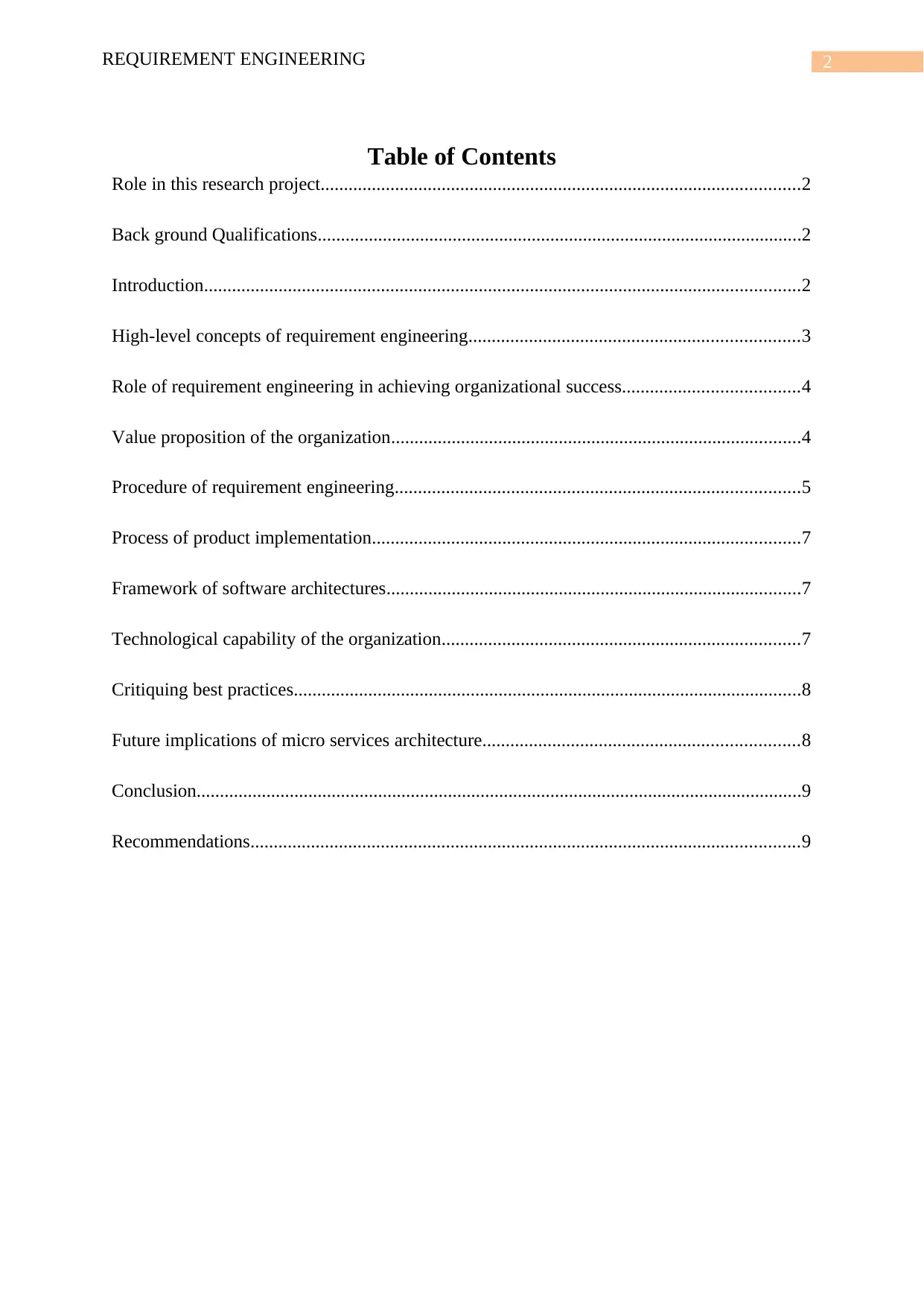
2REQUIREMENT ENGINEERING
Table of Contents
Role in this research project.......................................................................................................2
Back ground Qualifications........................................................................................................2
Introduction................................................................................................................................2
High-level concepts of requirement engineering.......................................................................3
Role of requirement engineering in achieving organizational success......................................4
Value proposition of the organization........................................................................................4
Procedure of requirement engineering.......................................................................................5
Process of product implementation............................................................................................7
Framework of software architectures.........................................................................................7
Technological capability of the organization.............................................................................7
Critiquing best practices.............................................................................................................8
Future implications of micro services architecture....................................................................8
Conclusion..................................................................................................................................9
Recommendations......................................................................................................................9
Table of Contents
Role in this research project.......................................................................................................2
Back ground Qualifications........................................................................................................2
Introduction................................................................................................................................2
High-level concepts of requirement engineering.......................................................................3
Role of requirement engineering in achieving organizational success......................................4
Value proposition of the organization........................................................................................4
Procedure of requirement engineering.......................................................................................5
Process of product implementation............................................................................................7
Framework of software architectures.........................................................................................7
Technological capability of the organization.............................................................................7
Critiquing best practices.............................................................................................................8
Future implications of micro services architecture....................................................................8
Conclusion..................................................................................................................................9
Recommendations......................................................................................................................9
⊘ This is a preview!⊘
Do you want full access?
Subscribe today to unlock all pages.

Trusted by 1+ million students worldwide
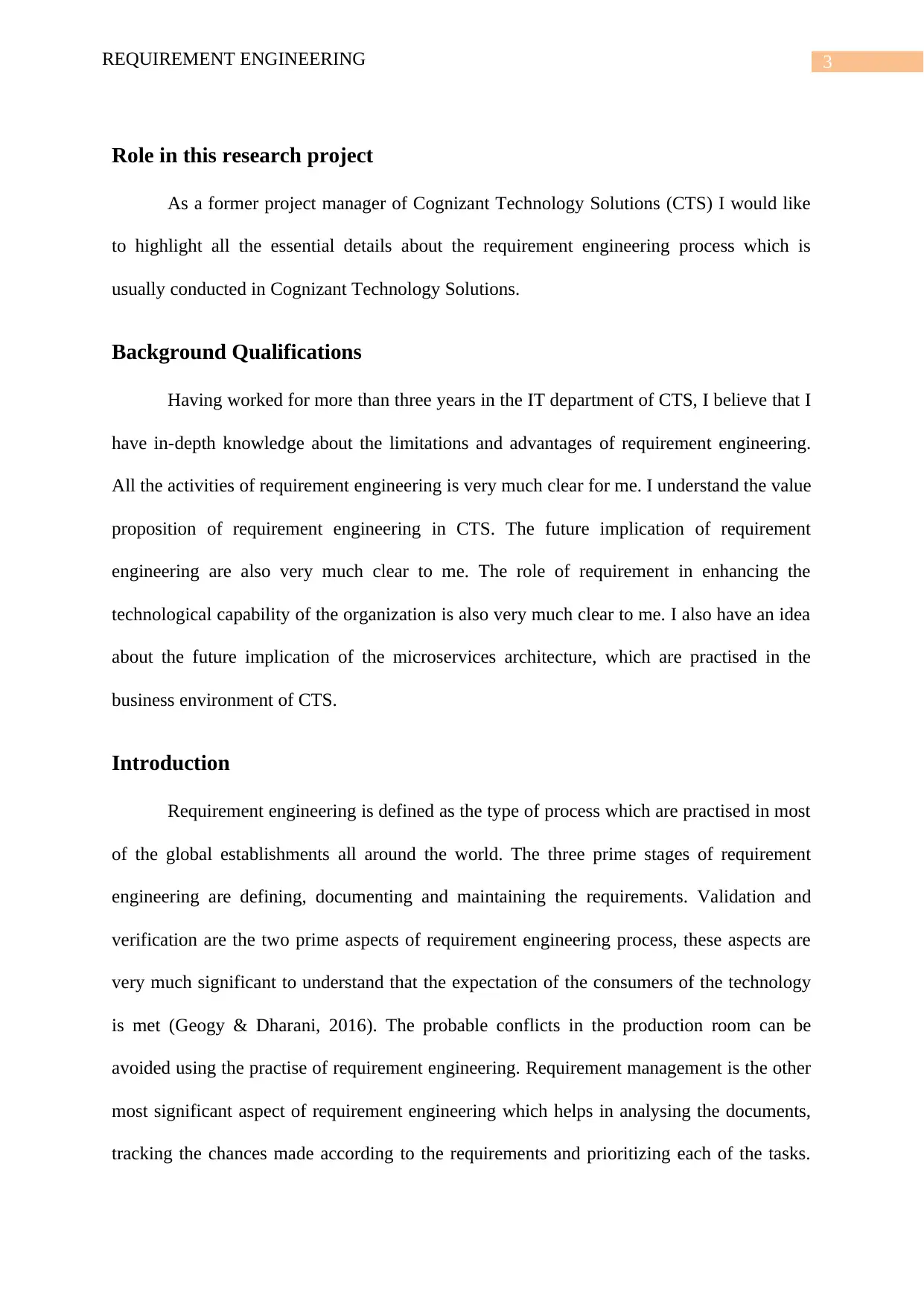
3REQUIREMENT ENGINEERING
Role in this research project
As a former project manager of Cognizant Technology Solutions (CTS) I would like
to highlight all the essential details about the requirement engineering process which is
usually conducted in Cognizant Technology Solutions.
Background Qualifications
Having worked for more than three years in the IT department of CTS, I believe that I
have in-depth knowledge about the limitations and advantages of requirement engineering.
All the activities of requirement engineering is very much clear for me. I understand the value
proposition of requirement engineering in CTS. The future implication of requirement
engineering are also very much clear to me. The role of requirement in enhancing the
technological capability of the organization is also very much clear to me. I also have an idea
about the future implication of the microservices architecture, which are practised in the
business environment of CTS.
Introduction
Requirement engineering is defined as the type of process which are practised in most
of the global establishments all around the world. The three prime stages of requirement
engineering are defining, documenting and maintaining the requirements. Validation and
verification are the two prime aspects of requirement engineering process, these aspects are
very much significant to understand that the expectation of the consumers of the technology
is met (Geogy & Dharani, 2016). The probable conflicts in the production room can be
avoided using the practise of requirement engineering. Requirement management is the other
most significant aspect of requirement engineering which helps in analysing the documents,
tracking the chances made according to the requirements and prioritizing each of the tasks.
Role in this research project
As a former project manager of Cognizant Technology Solutions (CTS) I would like
to highlight all the essential details about the requirement engineering process which is
usually conducted in Cognizant Technology Solutions.
Background Qualifications
Having worked for more than three years in the IT department of CTS, I believe that I
have in-depth knowledge about the limitations and advantages of requirement engineering.
All the activities of requirement engineering is very much clear for me. I understand the value
proposition of requirement engineering in CTS. The future implication of requirement
engineering are also very much clear to me. The role of requirement in enhancing the
technological capability of the organization is also very much clear to me. I also have an idea
about the future implication of the microservices architecture, which are practised in the
business environment of CTS.
Introduction
Requirement engineering is defined as the type of process which are practised in most
of the global establishments all around the world. The three prime stages of requirement
engineering are defining, documenting and maintaining the requirements. Validation and
verification are the two prime aspects of requirement engineering process, these aspects are
very much significant to understand that the expectation of the consumers of the technology
is met (Geogy & Dharani, 2016). The probable conflicts in the production room can be
avoided using the practise of requirement engineering. Requirement management is the other
most significant aspect of requirement engineering which helps in analysing the documents,
tracking the chances made according to the requirements and prioritizing each of the tasks.
Paraphrase This Document
Need a fresh take? Get an instant paraphrase of this document with our AI Paraphraser
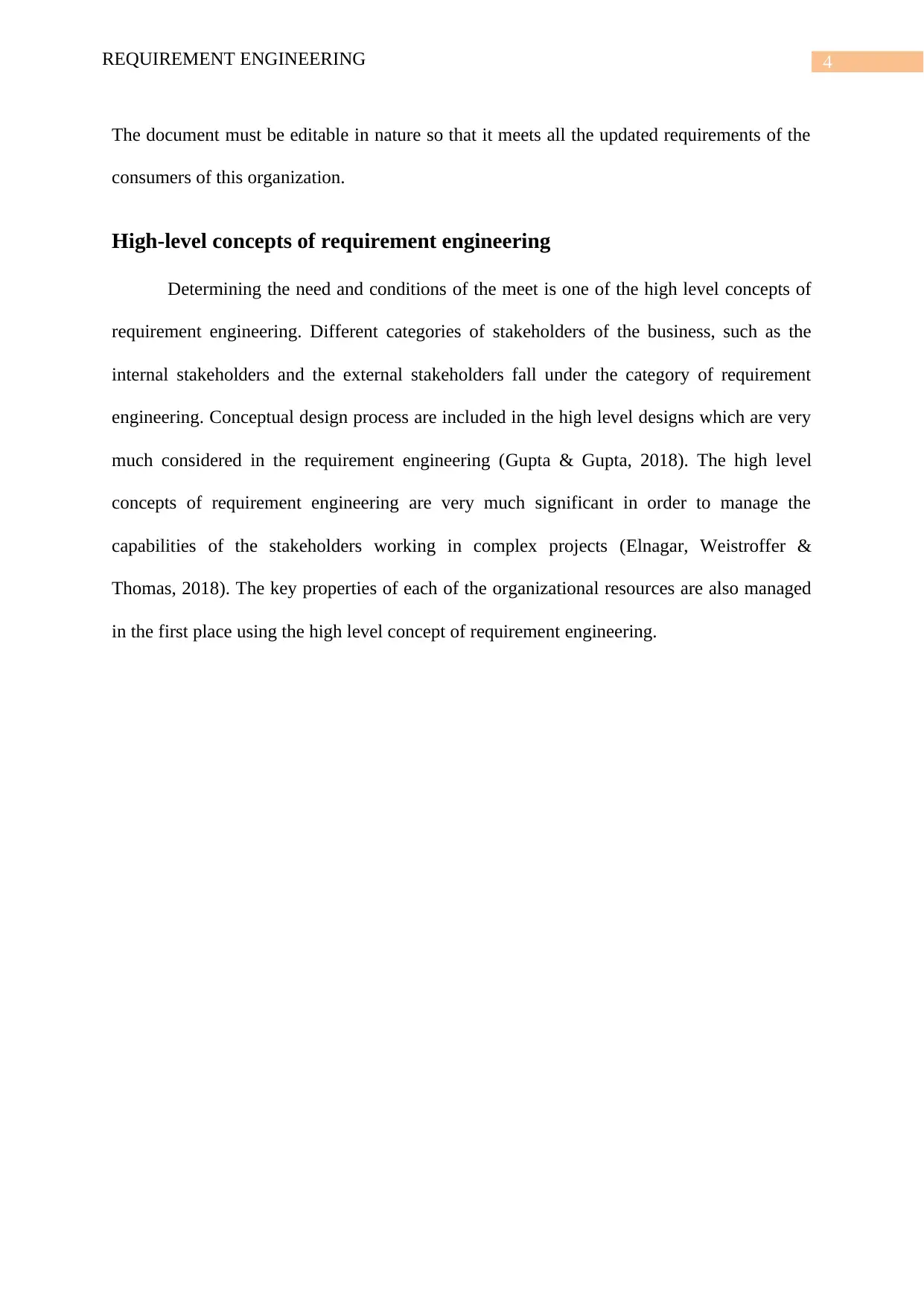
4REQUIREMENT ENGINEERING
The document must be editable in nature so that it meets all the updated requirements of the
consumers of this organization.
High-level concepts of requirement engineering
Determining the need and conditions of the meet is one of the high level concepts of
requirement engineering. Different categories of stakeholders of the business, such as the
internal stakeholders and the external stakeholders fall under the category of requirement
engineering. Conceptual design process are included in the high level designs which are very
much considered in the requirement engineering (Gupta & Gupta, 2018). The high level
concepts of requirement engineering are very much significant in order to manage the
capabilities of the stakeholders working in complex projects (Elnagar, Weistroffer &
Thomas, 2018). The key properties of each of the organizational resources are also managed
in the first place using the high level concept of requirement engineering.
The document must be editable in nature so that it meets all the updated requirements of the
consumers of this organization.
High-level concepts of requirement engineering
Determining the need and conditions of the meet is one of the high level concepts of
requirement engineering. Different categories of stakeholders of the business, such as the
internal stakeholders and the external stakeholders fall under the category of requirement
engineering. Conceptual design process are included in the high level designs which are very
much considered in the requirement engineering (Gupta & Gupta, 2018). The high level
concepts of requirement engineering are very much significant in order to manage the
capabilities of the stakeholders working in complex projects (Elnagar, Weistroffer &
Thomas, 2018). The key properties of each of the organizational resources are also managed
in the first place using the high level concept of requirement engineering.
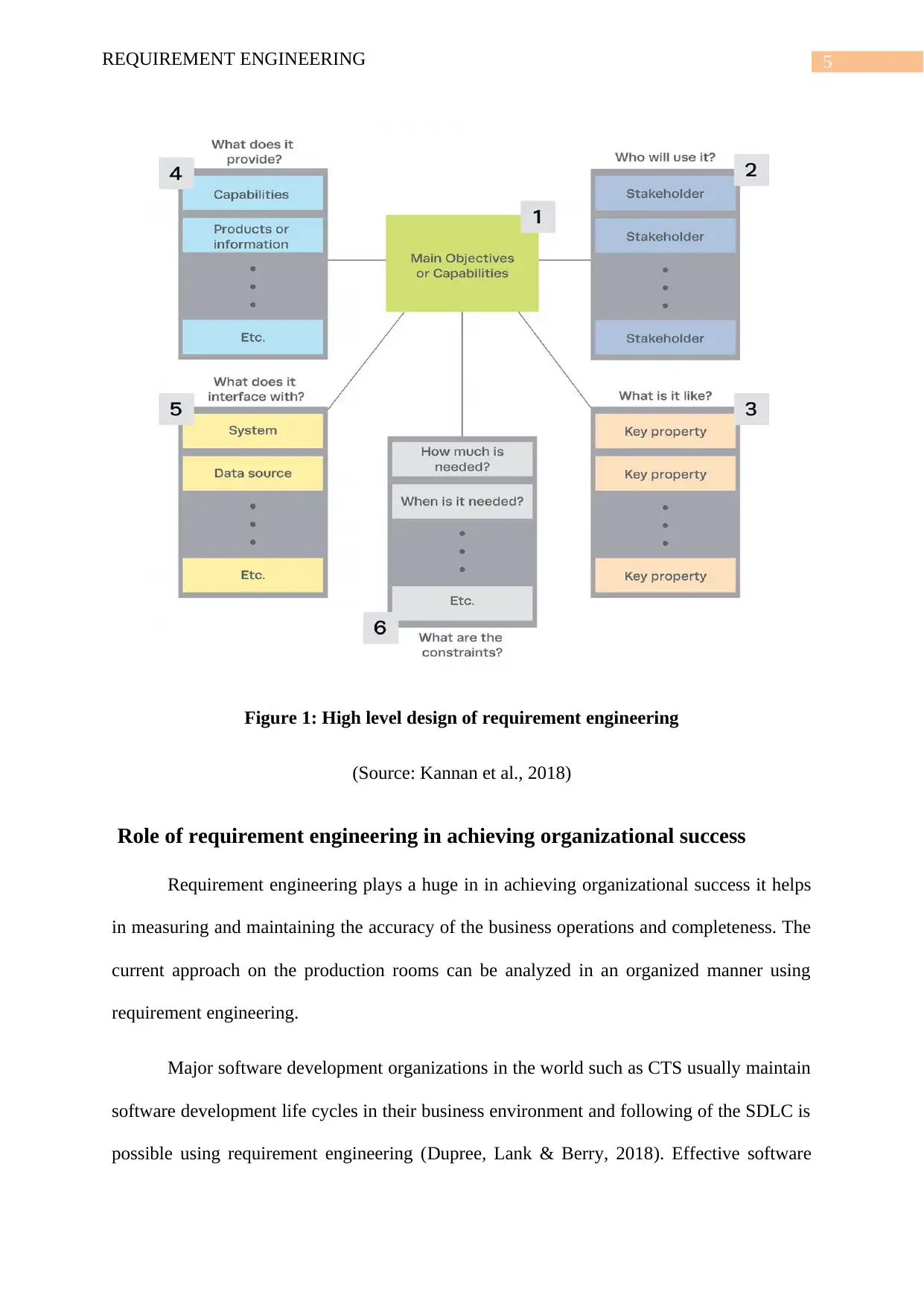
5REQUIREMENT ENGINEERING
Figure 1: High level design of requirement engineering
(Source: Kannan et al., 2018)
Role of requirement engineering in achieving organizational success
Requirement engineering plays a huge in in achieving organizational success it helps
in measuring and maintaining the accuracy of the business operations and completeness. The
current approach on the production rooms can be analyzed in an organized manner using
requirement engineering.
Major software development organizations in the world such as CTS usually maintain
software development life cycles in their business environment and following of the SDLC is
possible using requirement engineering (Dupree, Lank & Berry, 2018). Effective software
Figure 1: High level design of requirement engineering
(Source: Kannan et al., 2018)
Role of requirement engineering in achieving organizational success
Requirement engineering plays a huge in in achieving organizational success it helps
in measuring and maintaining the accuracy of the business operations and completeness. The
current approach on the production rooms can be analyzed in an organized manner using
requirement engineering.
Major software development organizations in the world such as CTS usually maintain
software development life cycles in their business environment and following of the SDLC is
possible using requirement engineering (Dupree, Lank & Berry, 2018). Effective software
⊘ This is a preview!⊘
Do you want full access?
Subscribe today to unlock all pages.

Trusted by 1+ million students worldwide
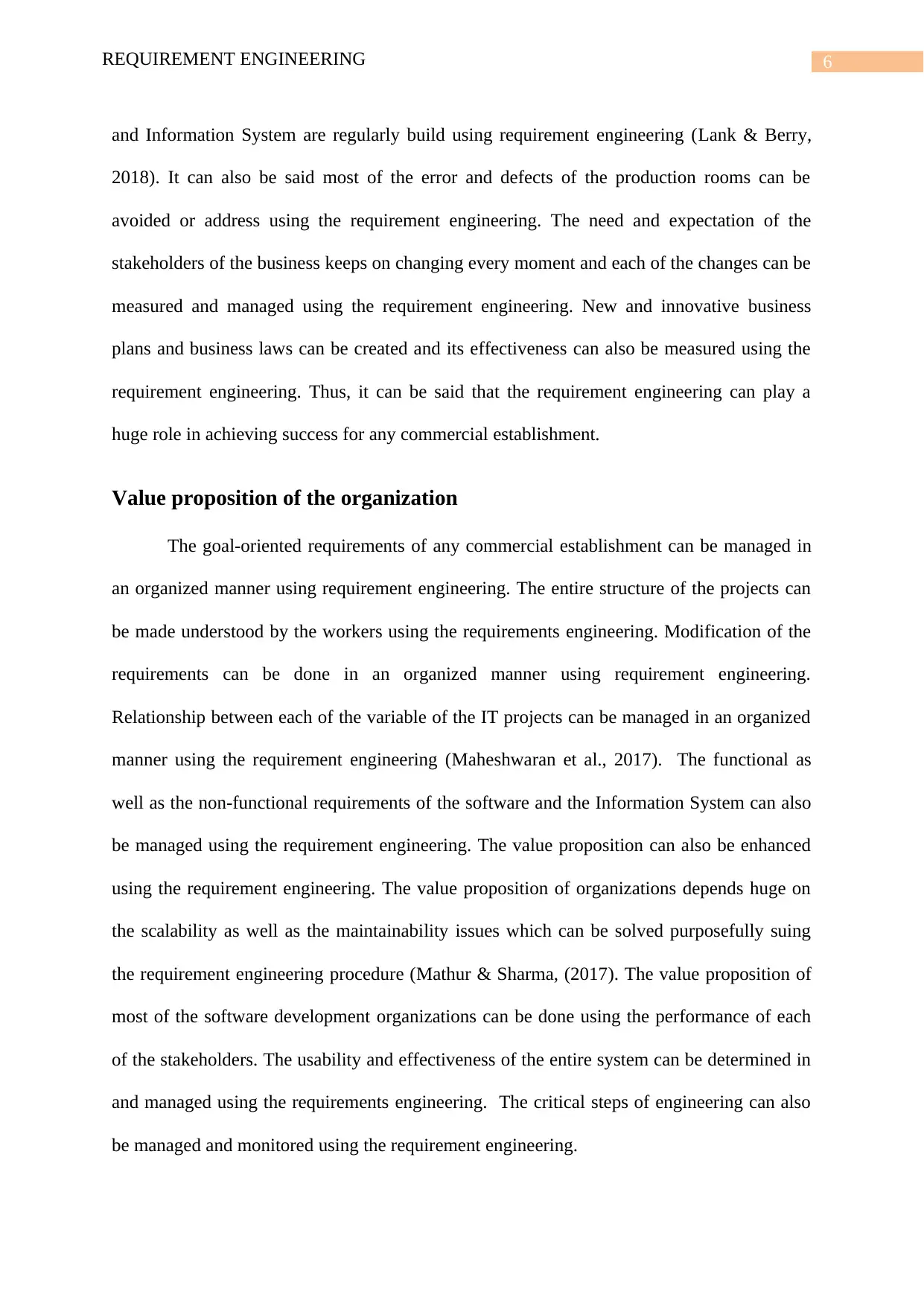
6REQUIREMENT ENGINEERING
and Information System are regularly build using requirement engineering (Lank & Berry,
2018). It can also be said most of the error and defects of the production rooms can be
avoided or address using the requirement engineering. The need and expectation of the
stakeholders of the business keeps on changing every moment and each of the changes can be
measured and managed using the requirement engineering. New and innovative business
plans and business laws can be created and its effectiveness can also be measured using the
requirement engineering. Thus, it can be said that the requirement engineering can play a
huge role in achieving success for any commercial establishment.
Value proposition of the organization
The goal-oriented requirements of any commercial establishment can be managed in
an organized manner using requirement engineering. The entire structure of the projects can
be made understood by the workers using the requirements engineering. Modification of the
requirements can be done in an organized manner using requirement engineering.
Relationship between each of the variable of the IT projects can be managed in an organized
manner using the requirement engineering (Maheshwaran et al., 2017). The functional as
well as the non-functional requirements of the software and the Information System can also
be managed using the requirement engineering. The value proposition can also be enhanced
using the requirement engineering. The value proposition of organizations depends huge on
the scalability as well as the maintainability issues which can be solved purposefully suing
the requirement engineering procedure (Mathur & Sharma, (2017). The value proposition of
most of the software development organizations can be done using the performance of each
of the stakeholders. The usability and effectiveness of the entire system can be determined in
and managed using the requirements engineering. The critical steps of engineering can also
be managed and monitored using the requirement engineering.
and Information System are regularly build using requirement engineering (Lank & Berry,
2018). It can also be said most of the error and defects of the production rooms can be
avoided or address using the requirement engineering. The need and expectation of the
stakeholders of the business keeps on changing every moment and each of the changes can be
measured and managed using the requirement engineering. New and innovative business
plans and business laws can be created and its effectiveness can also be measured using the
requirement engineering. Thus, it can be said that the requirement engineering can play a
huge role in achieving success for any commercial establishment.
Value proposition of the organization
The goal-oriented requirements of any commercial establishment can be managed in
an organized manner using requirement engineering. The entire structure of the projects can
be made understood by the workers using the requirements engineering. Modification of the
requirements can be done in an organized manner using requirement engineering.
Relationship between each of the variable of the IT projects can be managed in an organized
manner using the requirement engineering (Maheshwaran et al., 2017). The functional as
well as the non-functional requirements of the software and the Information System can also
be managed using the requirement engineering. The value proposition can also be enhanced
using the requirement engineering. The value proposition of organizations depends huge on
the scalability as well as the maintainability issues which can be solved purposefully suing
the requirement engineering procedure (Mathur & Sharma, (2017). The value proposition of
most of the software development organizations can be done using the performance of each
of the stakeholders. The usability and effectiveness of the entire system can be determined in
and managed using the requirements engineering. The critical steps of engineering can also
be managed and monitored using the requirement engineering.
Paraphrase This Document
Need a fresh take? Get an instant paraphrase of this document with our AI Paraphraser
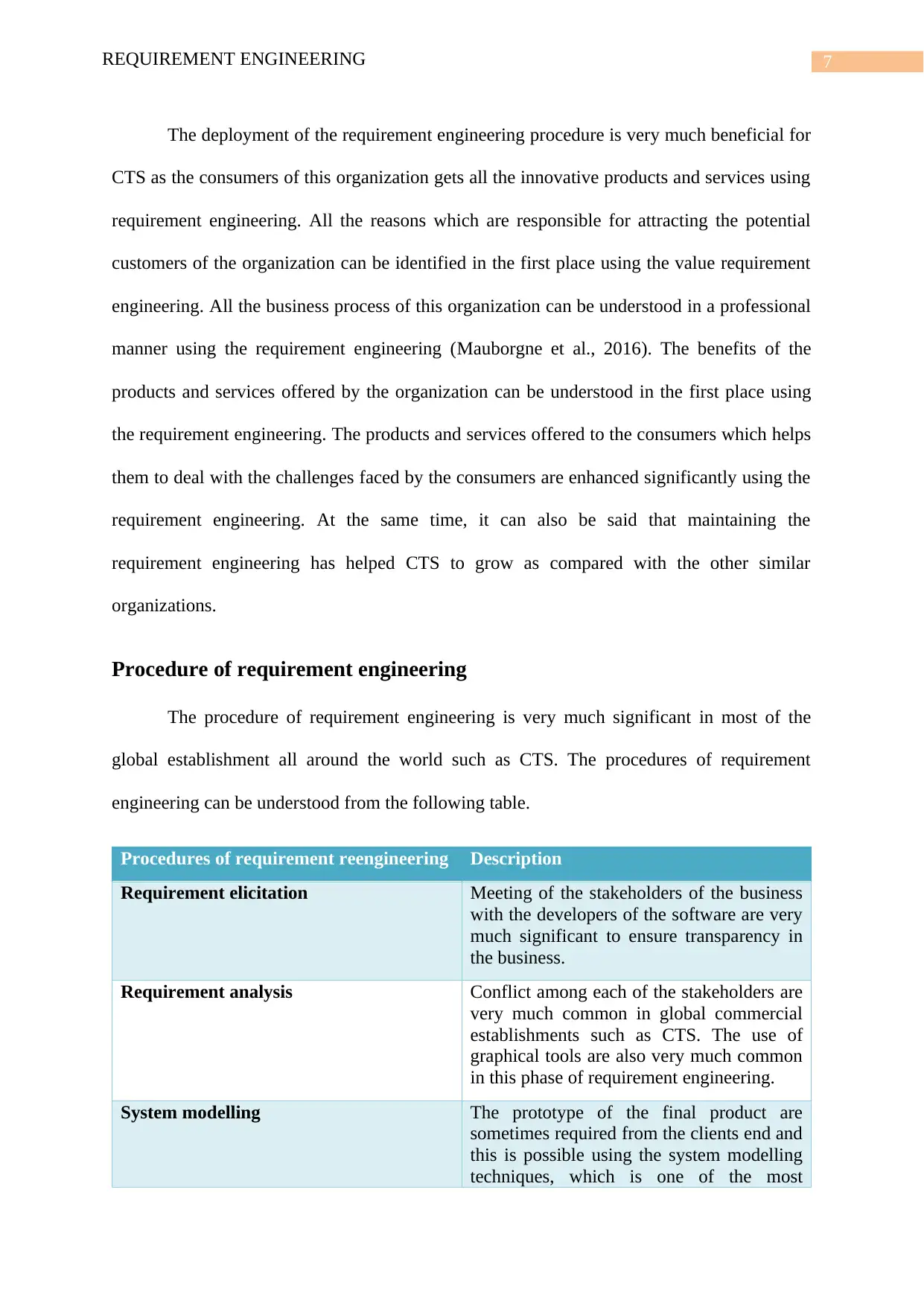
7REQUIREMENT ENGINEERING
The deployment of the requirement engineering procedure is very much beneficial for
CTS as the consumers of this organization gets all the innovative products and services using
requirement engineering. All the reasons which are responsible for attracting the potential
customers of the organization can be identified in the first place using the value requirement
engineering. All the business process of this organization can be understood in a professional
manner using the requirement engineering (Mauborgne et al., 2016). The benefits of the
products and services offered by the organization can be understood in the first place using
the requirement engineering. The products and services offered to the consumers which helps
them to deal with the challenges faced by the consumers are enhanced significantly using the
requirement engineering. At the same time, it can also be said that maintaining the
requirement engineering has helped CTS to grow as compared with the other similar
organizations.
Procedure of requirement engineering
The procedure of requirement engineering is very much significant in most of the
global establishment all around the world such as CTS. The procedures of requirement
engineering can be understood from the following table.
Procedures of requirement reengineering Description
Requirement elicitation Meeting of the stakeholders of the business
with the developers of the software are very
much significant to ensure transparency in
the business.
Requirement analysis Conflict among each of the stakeholders are
very much common in global commercial
establishments such as CTS. The use of
graphical tools are also very much common
in this phase of requirement engineering.
System modelling The prototype of the final product are
sometimes required from the clients end and
this is possible using the system modelling
techniques, which is one of the most
The deployment of the requirement engineering procedure is very much beneficial for
CTS as the consumers of this organization gets all the innovative products and services using
requirement engineering. All the reasons which are responsible for attracting the potential
customers of the organization can be identified in the first place using the value requirement
engineering. All the business process of this organization can be understood in a professional
manner using the requirement engineering (Mauborgne et al., 2016). The benefits of the
products and services offered by the organization can be understood in the first place using
the requirement engineering. The products and services offered to the consumers which helps
them to deal with the challenges faced by the consumers are enhanced significantly using the
requirement engineering. At the same time, it can also be said that maintaining the
requirement engineering has helped CTS to grow as compared with the other similar
organizations.
Procedure of requirement engineering
The procedure of requirement engineering is very much significant in most of the
global establishment all around the world such as CTS. The procedures of requirement
engineering can be understood from the following table.
Procedures of requirement reengineering Description
Requirement elicitation Meeting of the stakeholders of the business
with the developers of the software are very
much significant to ensure transparency in
the business.
Requirement analysis Conflict among each of the stakeholders are
very much common in global commercial
establishments such as CTS. The use of
graphical tools are also very much common
in this phase of requirement engineering.
System modelling The prototype of the final product are
sometimes required from the clients end and
this is possible using the system modelling
techniques, which is one of the most
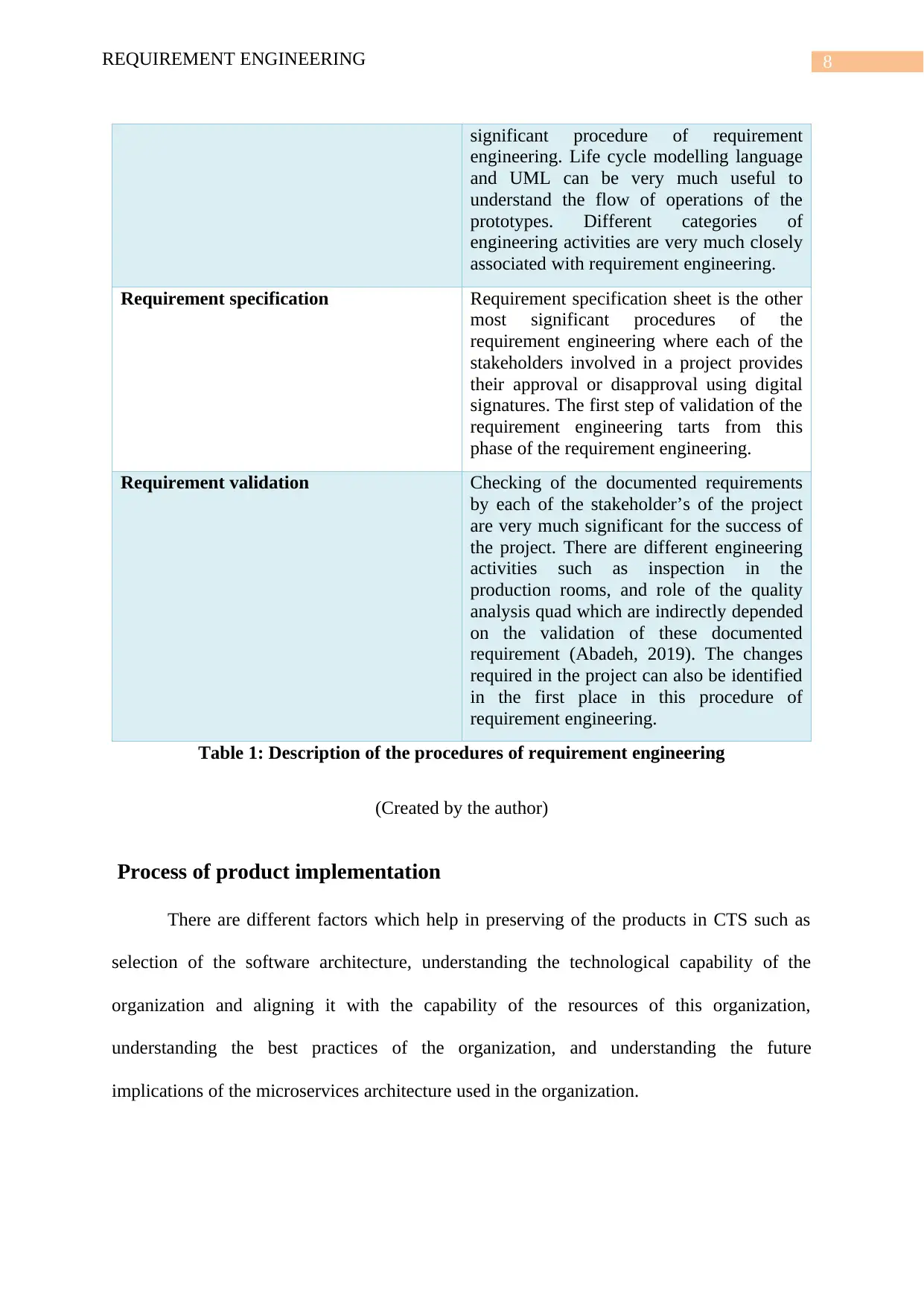
8REQUIREMENT ENGINEERING
significant procedure of requirement
engineering. Life cycle modelling language
and UML can be very much useful to
understand the flow of operations of the
prototypes. Different categories of
engineering activities are very much closely
associated with requirement engineering.
Requirement specification Requirement specification sheet is the other
most significant procedures of the
requirement engineering where each of the
stakeholders involved in a project provides
their approval or disapproval using digital
signatures. The first step of validation of the
requirement engineering tarts from this
phase of the requirement engineering.
Requirement validation Checking of the documented requirements
by each of the stakeholder’s of the project
are very much significant for the success of
the project. There are different engineering
activities such as inspection in the
production rooms, and role of the quality
analysis quad which are indirectly depended
on the validation of these documented
requirement (Abadeh, 2019). The changes
required in the project can also be identified
in the first place in this procedure of
requirement engineering.
Table 1: Description of the procedures of requirement engineering
(Created by the author)
Process of product implementation
There are different factors which help in preserving of the products in CTS such as
selection of the software architecture, understanding the technological capability of the
organization and aligning it with the capability of the resources of this organization,
understanding the best practices of the organization, and understanding the future
implications of the microservices architecture used in the organization.
significant procedure of requirement
engineering. Life cycle modelling language
and UML can be very much useful to
understand the flow of operations of the
prototypes. Different categories of
engineering activities are very much closely
associated with requirement engineering.
Requirement specification Requirement specification sheet is the other
most significant procedures of the
requirement engineering where each of the
stakeholders involved in a project provides
their approval or disapproval using digital
signatures. The first step of validation of the
requirement engineering tarts from this
phase of the requirement engineering.
Requirement validation Checking of the documented requirements
by each of the stakeholder’s of the project
are very much significant for the success of
the project. There are different engineering
activities such as inspection in the
production rooms, and role of the quality
analysis quad which are indirectly depended
on the validation of these documented
requirement (Abadeh, 2019). The changes
required in the project can also be identified
in the first place in this procedure of
requirement engineering.
Table 1: Description of the procedures of requirement engineering
(Created by the author)
Process of product implementation
There are different factors which help in preserving of the products in CTS such as
selection of the software architecture, understanding the technological capability of the
organization and aligning it with the capability of the resources of this organization,
understanding the best practices of the organization, and understanding the future
implications of the microservices architecture used in the organization.
⊘ This is a preview!⊘
Do you want full access?
Subscribe today to unlock all pages.

Trusted by 1+ million students worldwide
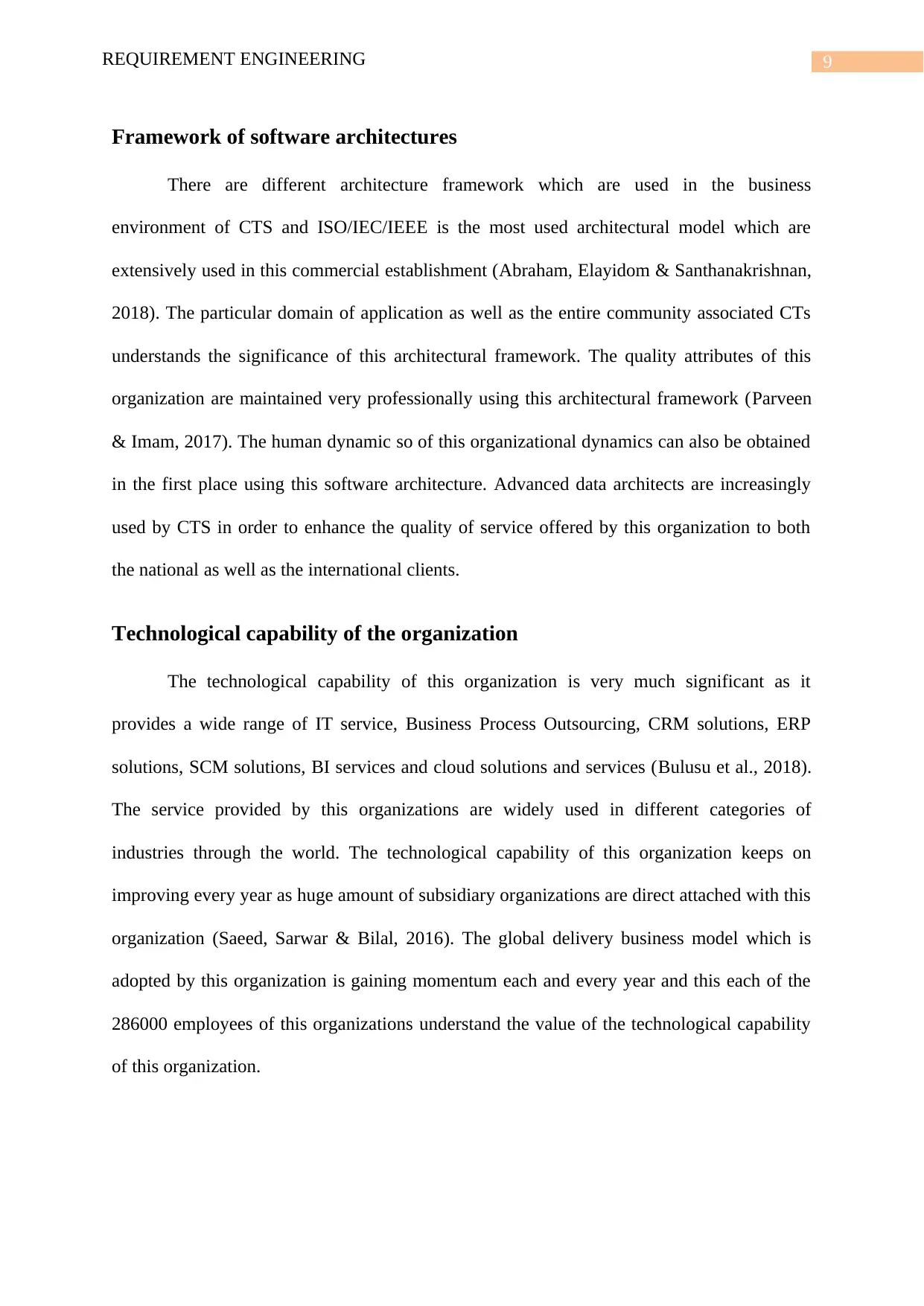
9REQUIREMENT ENGINEERING
Framework of software architectures
There are different architecture framework which are used in the business
environment of CTS and ISO/IEC/IEEE is the most used architectural model which are
extensively used in this commercial establishment (Abraham, Elayidom & Santhanakrishnan,
2018). The particular domain of application as well as the entire community associated CTs
understands the significance of this architectural framework. The quality attributes of this
organization are maintained very professionally using this architectural framework (Parveen
& Imam, 2017). The human dynamic so of this organizational dynamics can also be obtained
in the first place using this software architecture. Advanced data architects are increasingly
used by CTS in order to enhance the quality of service offered by this organization to both
the national as well as the international clients.
Technological capability of the organization
The technological capability of this organization is very much significant as it
provides a wide range of IT service, Business Process Outsourcing, CRM solutions, ERP
solutions, SCM solutions, BI services and cloud solutions and services (Bulusu et al., 2018).
The service provided by this organizations are widely used in different categories of
industries through the world. The technological capability of this organization keeps on
improving every year as huge amount of subsidiary organizations are direct attached with this
organization (Saeed, Sarwar & Bilal, 2016). The global delivery business model which is
adopted by this organization is gaining momentum each and every year and this each of the
286000 employees of this organizations understand the value of the technological capability
of this organization.
Framework of software architectures
There are different architecture framework which are used in the business
environment of CTS and ISO/IEC/IEEE is the most used architectural model which are
extensively used in this commercial establishment (Abraham, Elayidom & Santhanakrishnan,
2018). The particular domain of application as well as the entire community associated CTs
understands the significance of this architectural framework. The quality attributes of this
organization are maintained very professionally using this architectural framework (Parveen
& Imam, 2017). The human dynamic so of this organizational dynamics can also be obtained
in the first place using this software architecture. Advanced data architects are increasingly
used by CTS in order to enhance the quality of service offered by this organization to both
the national as well as the international clients.
Technological capability of the organization
The technological capability of this organization is very much significant as it
provides a wide range of IT service, Business Process Outsourcing, CRM solutions, ERP
solutions, SCM solutions, BI services and cloud solutions and services (Bulusu et al., 2018).
The service provided by this organizations are widely used in different categories of
industries through the world. The technological capability of this organization keeps on
improving every year as huge amount of subsidiary organizations are direct attached with this
organization (Saeed, Sarwar & Bilal, 2016). The global delivery business model which is
adopted by this organization is gaining momentum each and every year and this each of the
286000 employees of this organizations understand the value of the technological capability
of this organization.
Paraphrase This Document
Need a fresh take? Get an instant paraphrase of this document with our AI Paraphraser
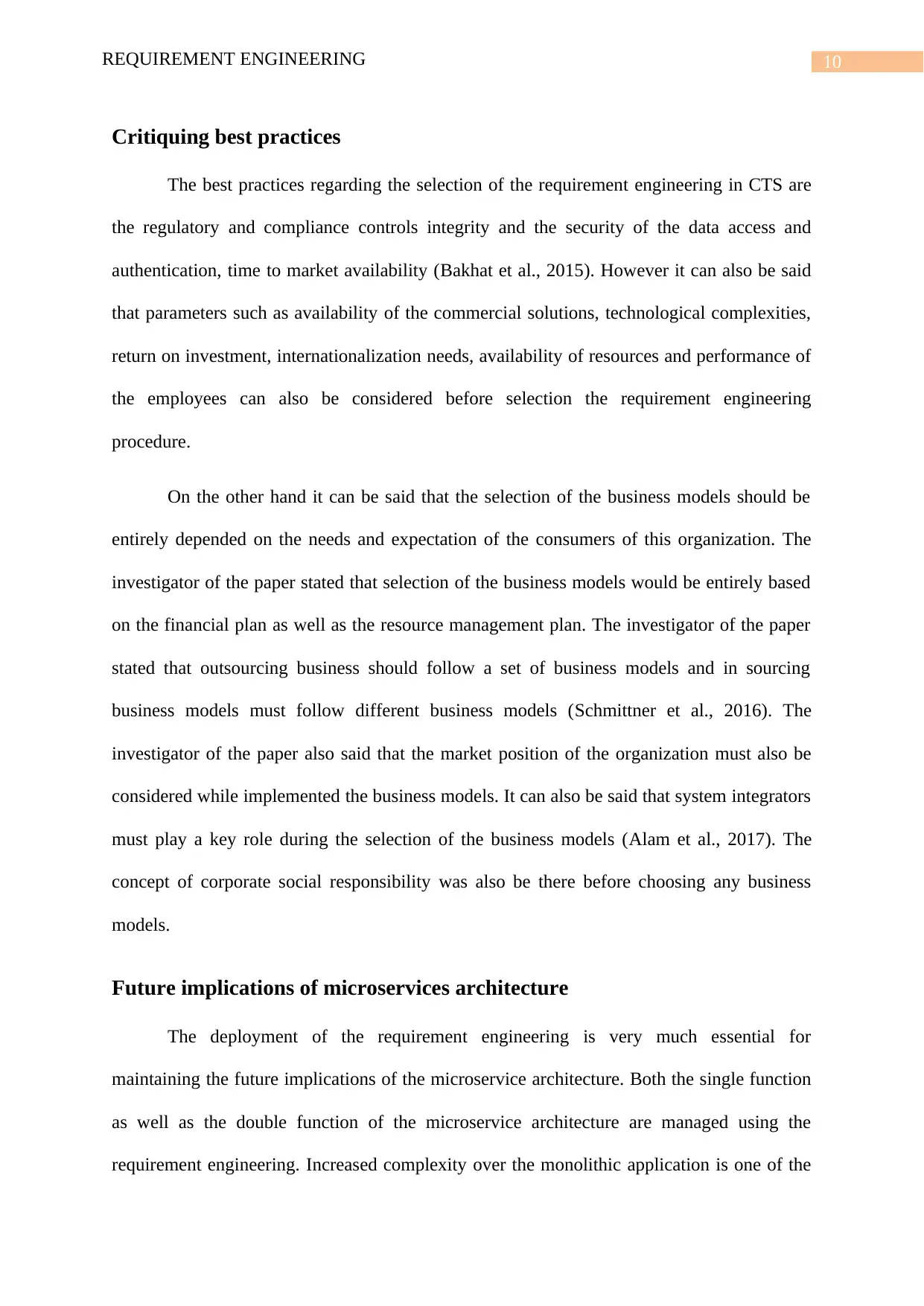
10REQUIREMENT ENGINEERING
Critiquing best practices
The best practices regarding the selection of the requirement engineering in CTS are
the regulatory and compliance controls integrity and the security of the data access and
authentication, time to market availability (Bakhat et al., 2015). However it can also be said
that parameters such as availability of the commercial solutions, technological complexities,
return on investment, internationalization needs, availability of resources and performance of
the employees can also be considered before selection the requirement engineering
procedure.
On the other hand it can be said that the selection of the business models should be
entirely depended on the needs and expectation of the consumers of this organization. The
investigator of the paper stated that selection of the business models would be entirely based
on the financial plan as well as the resource management plan. The investigator of the paper
stated that outsourcing business should follow a set of business models and in sourcing
business models must follow different business models (Schmittner et al., 2016). The
investigator of the paper also said that the market position of the organization must also be
considered while implemented the business models. It can also be said that system integrators
must play a key role during the selection of the business models (Alam et al., 2017). The
concept of corporate social responsibility was also be there before choosing any business
models.
Future implications of microservices architecture
The deployment of the requirement engineering is very much essential for
maintaining the future implications of the microservice architecture. Both the single function
as well as the double function of the microservice architecture are managed using the
requirement engineering. Increased complexity over the monolithic application is one of the
Critiquing best practices
The best practices regarding the selection of the requirement engineering in CTS are
the regulatory and compliance controls integrity and the security of the data access and
authentication, time to market availability (Bakhat et al., 2015). However it can also be said
that parameters such as availability of the commercial solutions, technological complexities,
return on investment, internationalization needs, availability of resources and performance of
the employees can also be considered before selection the requirement engineering
procedure.
On the other hand it can be said that the selection of the business models should be
entirely depended on the needs and expectation of the consumers of this organization. The
investigator of the paper stated that selection of the business models would be entirely based
on the financial plan as well as the resource management plan. The investigator of the paper
stated that outsourcing business should follow a set of business models and in sourcing
business models must follow different business models (Schmittner et al., 2016). The
investigator of the paper also said that the market position of the organization must also be
considered while implemented the business models. It can also be said that system integrators
must play a key role during the selection of the business models (Alam et al., 2017). The
concept of corporate social responsibility was also be there before choosing any business
models.
Future implications of microservices architecture
The deployment of the requirement engineering is very much essential for
maintaining the future implications of the microservice architecture. Both the single function
as well as the double function of the microservice architecture are managed using the
requirement engineering. Increased complexity over the monolithic application is one of the
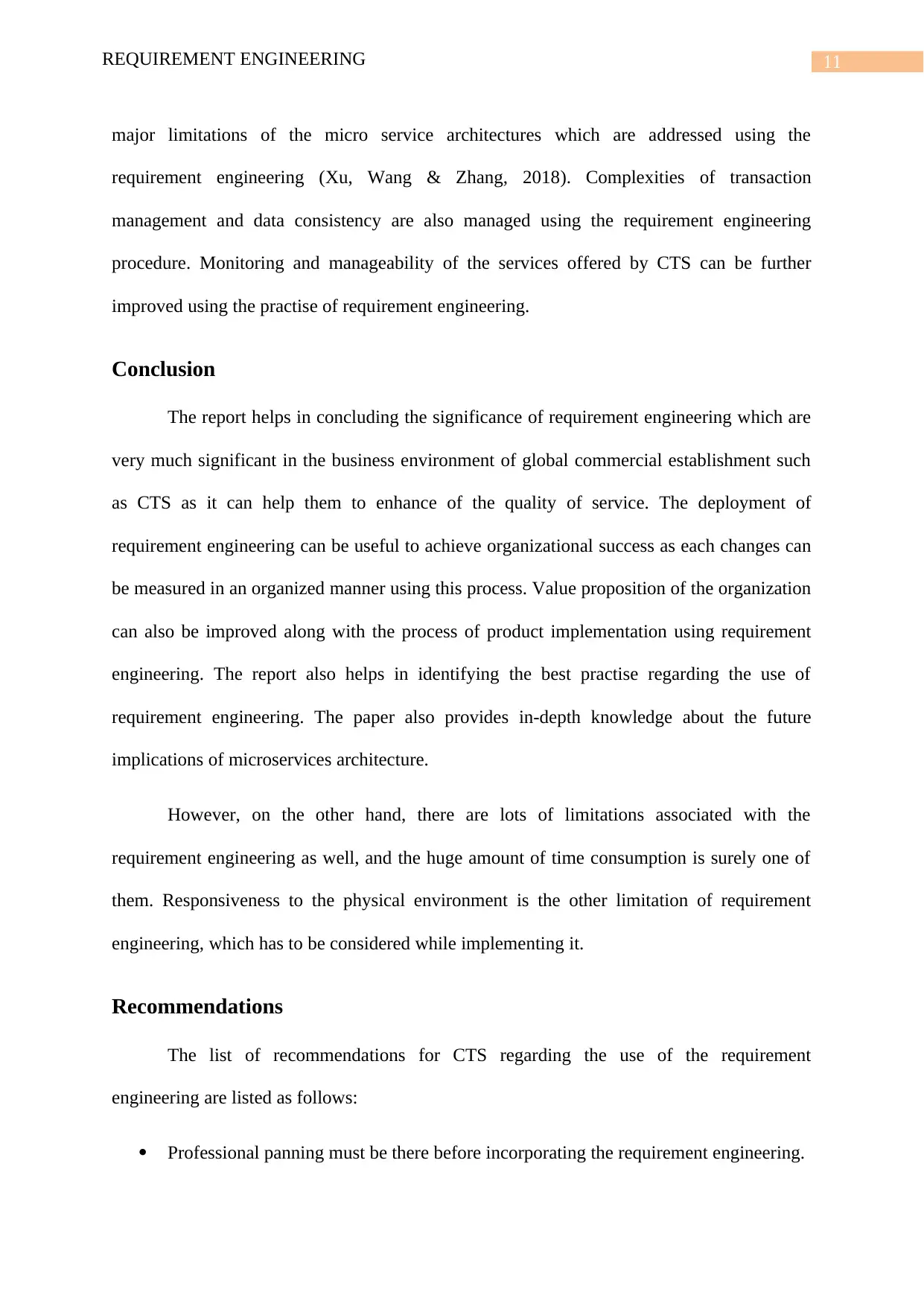
11REQUIREMENT ENGINEERING
major limitations of the micro service architectures which are addressed using the
requirement engineering (Xu, Wang & Zhang, 2018). Complexities of transaction
management and data consistency are also managed using the requirement engineering
procedure. Monitoring and manageability of the services offered by CTS can be further
improved using the practise of requirement engineering.
Conclusion
The report helps in concluding the significance of requirement engineering which are
very much significant in the business environment of global commercial establishment such
as CTS as it can help them to enhance of the quality of service. The deployment of
requirement engineering can be useful to achieve organizational success as each changes can
be measured in an organized manner using this process. Value proposition of the organization
can also be improved along with the process of product implementation using requirement
engineering. The report also helps in identifying the best practise regarding the use of
requirement engineering. The paper also provides in-depth knowledge about the future
implications of microservices architecture.
However, on the other hand, there are lots of limitations associated with the
requirement engineering as well, and the huge amount of time consumption is surely one of
them. Responsiveness to the physical environment is the other limitation of requirement
engineering, which has to be considered while implementing it.
Recommendations
The list of recommendations for CTS regarding the use of the requirement
engineering are listed as follows:
Professional panning must be there before incorporating the requirement engineering.
major limitations of the micro service architectures which are addressed using the
requirement engineering (Xu, Wang & Zhang, 2018). Complexities of transaction
management and data consistency are also managed using the requirement engineering
procedure. Monitoring and manageability of the services offered by CTS can be further
improved using the practise of requirement engineering.
Conclusion
The report helps in concluding the significance of requirement engineering which are
very much significant in the business environment of global commercial establishment such
as CTS as it can help them to enhance of the quality of service. The deployment of
requirement engineering can be useful to achieve organizational success as each changes can
be measured in an organized manner using this process. Value proposition of the organization
can also be improved along with the process of product implementation using requirement
engineering. The report also helps in identifying the best practise regarding the use of
requirement engineering. The paper also provides in-depth knowledge about the future
implications of microservices architecture.
However, on the other hand, there are lots of limitations associated with the
requirement engineering as well, and the huge amount of time consumption is surely one of
them. Responsiveness to the physical environment is the other limitation of requirement
engineering, which has to be considered while implementing it.
Recommendations
The list of recommendations for CTS regarding the use of the requirement
engineering are listed as follows:
Professional panning must be there before incorporating the requirement engineering.
⊘ This is a preview!⊘
Do you want full access?
Subscribe today to unlock all pages.

Trusted by 1+ million students worldwide
1 out of 16
Related Documents
Your All-in-One AI-Powered Toolkit for Academic Success.
+13062052269
info@desklib.com
Available 24*7 on WhatsApp / Email
![[object Object]](/_next/static/media/star-bottom.7253800d.svg)
Unlock your academic potential
Copyright © 2020–2025 A2Z Services. All Rights Reserved. Developed and managed by ZUCOL.





